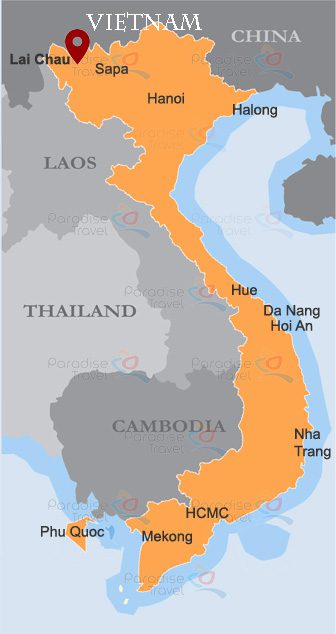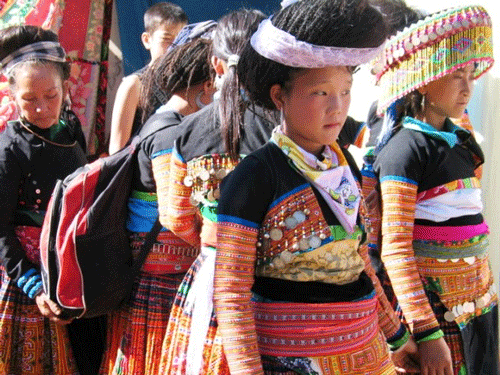Lai Chau Travel Guide

General Information
Lai Chau, a province in the Northwest region of Vietnam, adjacent to Yunnan province – China in the north, Dien Bien in the west and southwest, Lao Cai in the east, Yen Bai in the southeast and Son La in the south. Covering an area of 9,068.7 square kilometers, and being the homeland of 370,135 peoples, Lai Chau is set in a very important strategic position in terms of national defense and security. When it comes to tourism potential, Lai Chau owns not only the mysterious charm, a wild stunning beauty of rolling mountains, wild forests, gentle but violent streams and the endless sound of the mountain and forest but also the diversity in cultural identities of ethnic groups that carry the most typical feature of a Northern Province. This is an interesting destination for your eco tour in Vietnam.
Located about 400km far from Hanoi to the southeast, Lai Chau is situated on a high mountainous region in Northwest Vietnam, northern of Da River. Lai Chau terrain is constituted by a mountain ranges following Northern West – Southern East. The highest peak is The Pu Sa Leng – 3096m high. Besides, there consists of sloping mountains, spring, plateau, hill, and valley alternately.
Lai Chau Weather
Lai Chau has a tropical monsoon climate with hot days and cold nights. The best times to travel to Lai Chau are springs (February to April) and winters (November – January). The annual temperatures range is from 21oC to 23oC. The yearly weather pattern is as follows:
- May to September: rainy season, high temperatures and humidity
- November to March: dry season, cold weather, low humidity

- Weather in Lai Chau
Ethnic Minorities in Lai Chau

- La Hu ethnic people in Lai Chau
Similar to other Northern Provinces, 80 percents of Lai Chau’s population is ethnic minorities that make up a colorful picture of cultural diversity. There are more than 400 thousand people of 20 ethnic groups living together, in which the majority is Thai ethnic people, with 131,822 people, accounting for 34% of the total ethnic minorities. Additionally, Mong ethnics constitutes 22.30% (86,467 people), Kinh ethnic group consists of 54,027 people (13.94%), Dao ethnic people 51,995 people (13.41%), Ha Nhi ethnic people 14,658 people (3.78%) and other ethnic minorities.

- Ha Nhi people in Muong Te (Lai Chau)
Such numerous ethnic groups make Lai Chau a home to both tangible and intangible heritage items. Many can be listed as stilt houses of Thai and Mong ethnic people, brocade weaving, ‘dan tinh’ (handmade gourd lutes), ‘hat then’ (then singing), ‘mua xoe’ (circle dance) and gong festivals. Also, Lai Chau is the destination of a plenty of traditional festivals such as ‘le cap sac’ (maturity ritual) of Dao ethnic people, ‘le cau phuc’ (happiness praying) of Mong ethnic group, circle dance and gong festival of the Thai ethnic group and the traditional Tet holiday of Mong people.
Getting to Lai Chau
By bus
From the town of Sapa, you can catch a local bus through Tram Ton Pass (a scenic ride) to Lai Chau.
Also, you can take direct buses from the towns of Dien Bien, Son La, Mu Cang Chai (Yen Bai) to Lai Cha town.
From Hanoi, you can take a direct bus from the My Dinh or Giap Bat bus stations. It often takes you 7-12 hours, depending upon the company and on the bus route, stops,…
By bike
Lai Chau town is about 70km from Sapa, so you travel there on a motorbike from Sapa.
What to See in Lai Chau
1. Sin Ho Plateau
A trip to Sin Ho village is really an off-the-beaten-track journey to all arrivals on a tour to Northern Vietnam. Sin Ho village, located in Sin Ho district, Lai Chau Province, about 60km to the west of Lai Chau city, is considered as ‘the roof of Lai Chau province’ with an altitude of 1,500m and the cool climate all year round. The village has attracted more and more tourists in recent years thanks to its unspoiled nature the diverse cultures of local ethnic minorities.

- Sin Ho
Coming to there, tourists will be appealed by abundant stunning and picturesque landscapes such as O Rocky Mountain, Tien Cave, Pu Sam Cap cave ensemble, Sin Ho Stream, etc. When deeply learning about the daily life and unique customs of ethnic groups there, you can pay a visit to the villages of Pu Dao, Ta Ghenh, Hoang Ho, Ta Phin, Phang Xo Lin, etc or integrating into highland markets on weekends. Particularly, you can have a great experience of different types of cure methods such as medicinal herb bath, massage, and point acupuncture services on your tour to Vietnam.
Some should be recommended to bring along:
- Motorbike: it could be rented
- Sleeping bags and tent: in case that you cannot find any accommodation.
- Food and water
- Raincoat and warm clothes: it can be chilly at night and early in the morning. Lai Chau weather is very unpredictable and rains can happen quite often
- The app maps
2. Pu Sam Cap Cave

- Pu Sam Cap Cave
The creator has granted Lai Chau many majestic mountain ranges, lush green forests, beautiful rivers, and streams….Among these, Pu Sam Cam is the brightest tourism point, a must-see destination for a tour to the Northwest.
Pu Sam Cap cave, a limestone mountain range formed from the tectonic era, is on the way to Sin Ho plateau. This complex consists of 3 big caves named Thien Mon (Heaven Gate), Thien Duong (Paradise) and Thuy Tinh (Glass). With wild and mysterious scenery, Pu Sam Cap cave has been luring intrepid tourists.
3. Hoang Lien Son National Park

- Hoang Lien Son National Park
Hoang Lien Son National Park is one of the important special-use forests of Vietnam for ecotourism and scientific research. On the northwest of the Hoang Lien mountain range located the highest peak Fansipan Indochina (at 3,143m). There are 2,024 species of 200 families of plants, including 66 species in the Red Data Book of Vietnam, 32 rare species, 11 endangered species such as blue cypress, bamboo, red pine. Apart from this, there are 700 species of medicinal plants, such as rhododendron, needle, cardamom, etc.
You can have trekking and overnight camping trips or enjoy a lot of other activities such as archery, bird watching and learning how to walk on stilts.
4. Tam Duong Market

- Tam Duong Market
Tam Duong is the town between Sapa and Lai Chau. Tam Duong market is a typical mountain market. On the midway through town on National Highway 2, the local market is a must-see visit.
Being at the foot of Hoang Lien Son mountain range, Tam Duong market is not only the trading place for local specialties and production tools but also the meeting point for the Dao, Mong, Thai, Giay, and Lu ethnic minority people on every Thursday and Sunday.
When shopping in this market, you will be lost in the middle of abundant locally-made products which reflect the local culture. Market goers, in their hand-made colorful costumes, sell even locally-made musical instruments like flutes and pipes.
What to Eat in Lai Chau
1. Purple sticky rice

- Purple Sticky Rice
This food is prepared by the skillful hands of the Thai, and Day women….The local women often say they have their own secrets to cook this food, so the taste of this rice is unique and special which attracts all the visitors from near or far.
Khau Cam (its medical name is Hedyotis capitellata), the ingredient makes the purple color, is mixed with the scented sticky rice which has been washed and soaked in water from previous 6 hours. This food is the reason for many tourists to come back there again.
2. Smoked Pork

- Smoked Pork
This food is originated from the Pu Na people, but then it is extended to be the traditional food of some highland people. This dish has a typical mountainous as well as impressive taste.
This kind of Jambon must be done in winter. If not, this will fail and unable to eat. To cook this food, locals marinate pork in a long time about 5-7 days, then hung up in the kitchen and smoked until meat is dry, fat is melted. The typical seasoning for this food is Mac Khen ( a kind of spices made of seeds from Mac Khen trees).
3. Diplazium esculentum Salad (nom rau don)

- Nom rau don
This is the typical dish of Thai people in Lai Chau. To prepare this salad, the freshest shoots of the diplazium esculentum is chosen, then cleaned and dried under the sun. Then, it will be put in a pot called ‘Cho’ to steam them within about 20 minutes to keep them green. After finishing, the food will be mixed with spices: chili, lemon, ginger,….
When enjoying the food, you will feel the sweet and buttery taste of the diplazium esculentum as well as the sour and spicy different spices.










